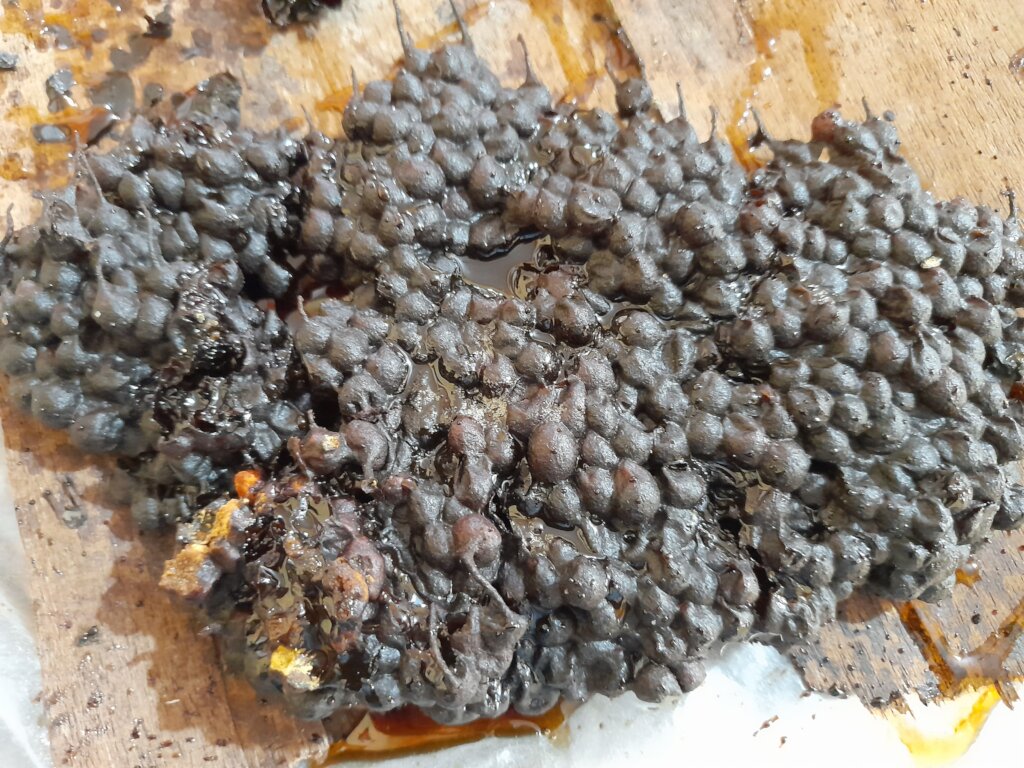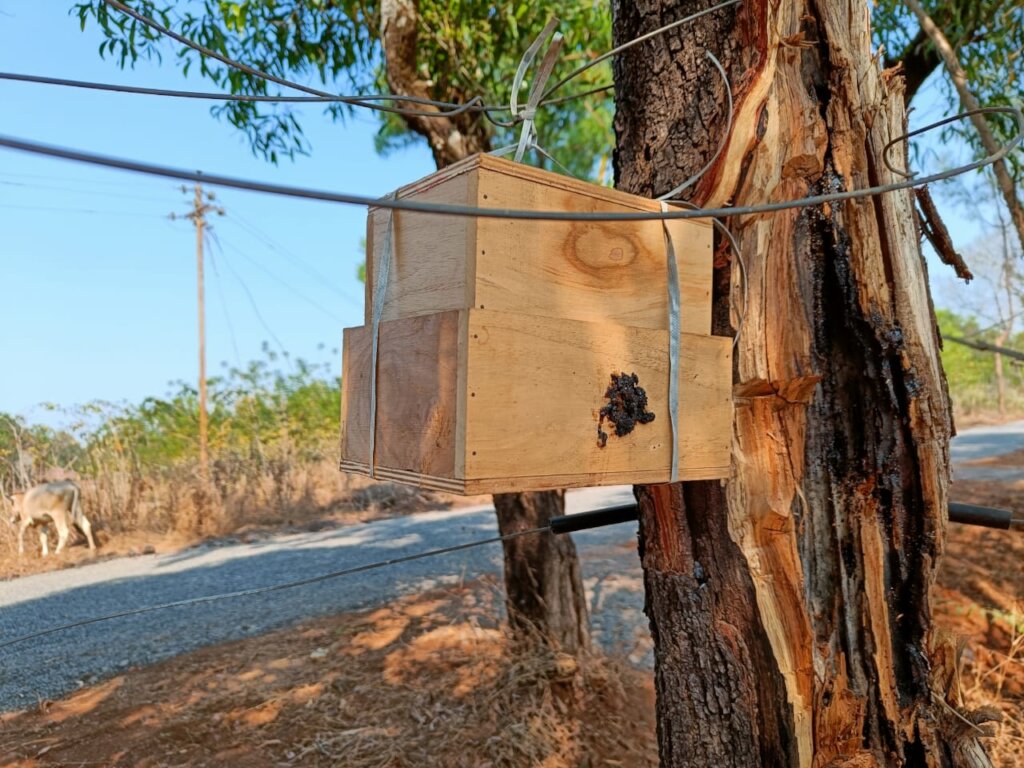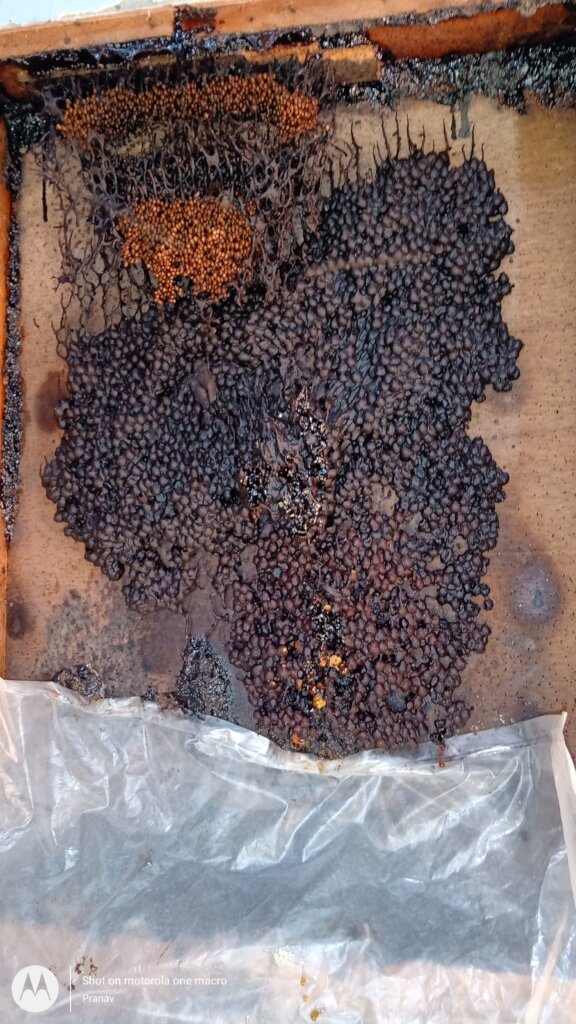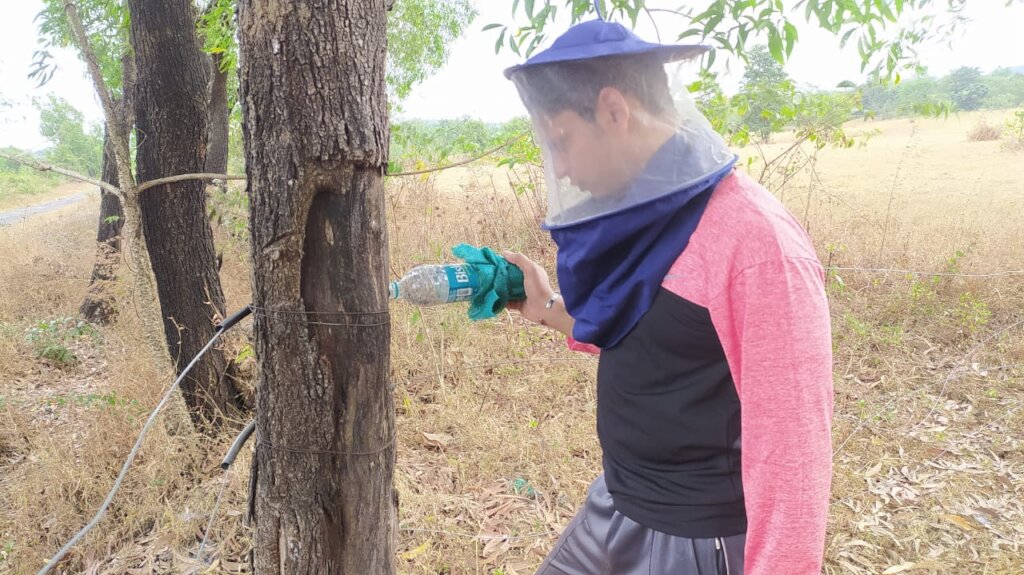By Akshay Gawade | Project leader
Dear Supporter,
I am trying to narrate a story of painstaking efforts made by our team members in rearing stingless bees so that we are able to sustain their colony and understand how they behave in an artificial environment ( bee box) in the last quarter.
The word “honeybee” conjures up images of a swarm of bees attacking and stinging people, and popular media has further fuelled the fear associated with bees through striking imageries. However, in reality, bees play an extremely important role in maintaining the functionalities of the ecosystems that they are a part of, pollinating a variety of crop plants and proving to be an important component of food security for humans.
India has four species of indigenous honey bees – Apis cerana indica, Apis dorsata, Apis florea, and Tetragonula iridipennis, i.e., the Indian stingless bee or Dammar bee. Apis cerana has been the most commonly reared species in the Indian beekeeping, i.e., apiculture sector. However, the demand and scope for stingless beekeeping has been increasing in the recent years. Also known as meliponiculture, stingless beekeeping is a sustainable activity that entails rearing bees to produce valuable products such as honey, propolis, pollen, and wax and increase the pollination and productivity of several economically important crops. Stingless bees have a sting that is non-functional, and it became as such during the evolution of this sub-group. This makes these bees less offensive and easier to rear than normal Apis bees and also suitable pollinators for crops cultivated in human-inhabited areas. Stingless bee colonies are also naturally long-lived. Moreover, the stingless bee honey is sold at higher market prices than honey from Apis bees. All these traits make stingless beekeeping a more economically attractive alternative to traditional beekeeping, as well as an effective sustainable livelihood option.
The Applied Environmental Research Foundation, an environmental NGO in Pune, has recognized the importance of sustainable beekeeping and its beneficial effects for both ecology and local livelihoods, and in order to learn more about stingless beekeeping, one of our team members, Mr Pranav Panvalkar, met Mr. Milind Yadav at Matrumandir farm at Ozare in March 2021. Mr. Yadav has extensive experience in beekeeping for the last 20 years. In January 2022, he transferred an Apis cerana colony to the bee box at Matrumandir farm and that is when Mr. Pranav re-established contact with him. Mr Yadav had one Apis cerana bee box and 15-18 stingless bee boxes at the farm at the time, and he had been working in stingless beekeeping for the last 2-3 years. Mr. Pranav decided to buy a box of stingless bees as a pilot attempt at rearing them after listening to Mr. Yadav’s experience.
The colony was established two months before Mr. Pranav bought the bee box, and the main task was to observe whether the worker bees collect pollen and nectar and remove the waste material from the box.
After this experience of rearing one bee box, Mr. Pranav decided to buy another stingless bee box. An existing stingless bee colony in Mr. Pranav’s vicinity was transferred to a new bee box, and Mr Pranav started rearing this colony.
The bee box had a simple structure: a 7 inch round PVC pipe of an approximate length of 14 inches. The ends of the pipe were covered using a wooden plate, and the pipe itself was divided with a wooden plate into two compartments, a brood compartment and a honey storage compartment. With this arrangement, the honey can be harvested from the honey storage compartment without disturbing the brood compartment.
During his observations, Mr. Pranav noted that stingless bees store and prepare their hive in a specific manner. Pollen is stored in the first part of the hive that is prepared during the hive construction, and then the bees search for a secure place for laying eggs, while in the remaining area, they store honey. In order to establish a colony in a new bee box, the brood area, which is yellowish white in colour containing rounded eggs, is collected. Along with this, a very small amount of pollen and honey is also added to the bee box. This is a quick procedure and does not disturb the bee colony. Then, the entire hive area is covered with soil or any powder to remove the smell of the old hive. Since the queen bee is already inside the bee box, all the worker bees also move inside the bee box. After this, the bee box needs to be kept at the same place so that all the bees get familiar with it. After 2–3 days, the bee box can be shifted at a suitable place at night.
There are two important differences in stingless bee and Apis cerana bee keeping, which Mr. Pranav noted during his experience of beekeeping. The first difference was that stingless bees did not show absconding behaviour during one year of his experience. Absconding is the term used when all of the bees, including the queen bee, completely leave the hive due to various reasons such as food scarcity, disturbances like loud noises and overheating, parasites, or predators. Other stingless beekeepers have also corroborated Mr. Pranav’s observations in this regard. The second important advantage of stingless bees is that they are very low maintenance, and beekeepers do not need to invest a lot of time in cleaning and maintaining the colony.
Since March 2022, Mr. Pranav has harvested four stingless bee colonies, and successfully shifted them to different bee boxes, where each of the individual colonies are thriving. For the first two bee colonies, Mr. Pranav assisted Mr. Yadav, and after this experience, he decided to harvest a new colony on his own. Mr. Pranav harvested his first colony of stingless bees in August 2022 in a wooden box. The box was made up of two parts, and plywood was used to separate one part from the other. Mr. Pranav was apprehensive about the survival of the colony during the month of August, since it was monsoon and there were very few flowering plants for the bees to collect nectar from, however, the colony survived successfully and that boosted his confidence in harvesting a colony on his own. He followed it up with harvesting one more stingless bee colony in December 2022, which he also was able to successfully shift into a wooden bee box.
In the upcoming season, Mr. Pranav has planned to harvest ten more stingless bee colonies and is trying to prepare a vertical model of the PVC pipe bee box for this endeavour.
While it could be boring to read this progress report on activities, for us these efforts has provided an important learning- we need to be persistent and patient with our efforts if we really wish to preserve wonders of nature by understanding their behaviour.
Thanks for your understanding.
Akshay
Project reports on GlobalGiving are posted directly to globalgiving.org by Project Leaders as they are completed, generally every 3-4 months. To protect the integrity of these documents, GlobalGiving does not alter them; therefore you may find some language or formatting issues.
If you donate to this project or have donated to this project, you can receive an email when this project posts a report. You can also subscribe for reports without donating.
Support this important cause by creating a personalized fundraising page.
Start a Fundraiser


